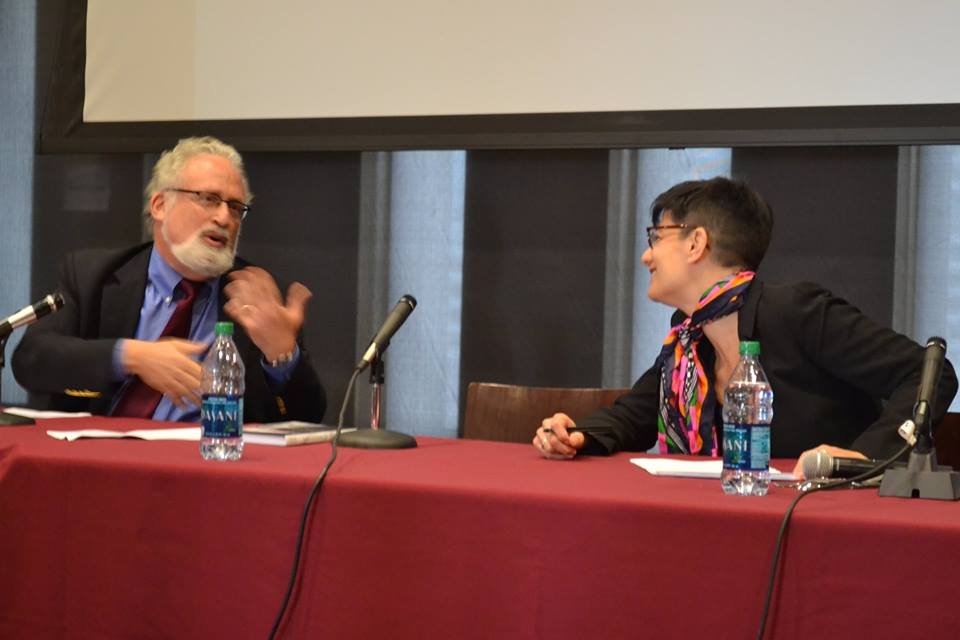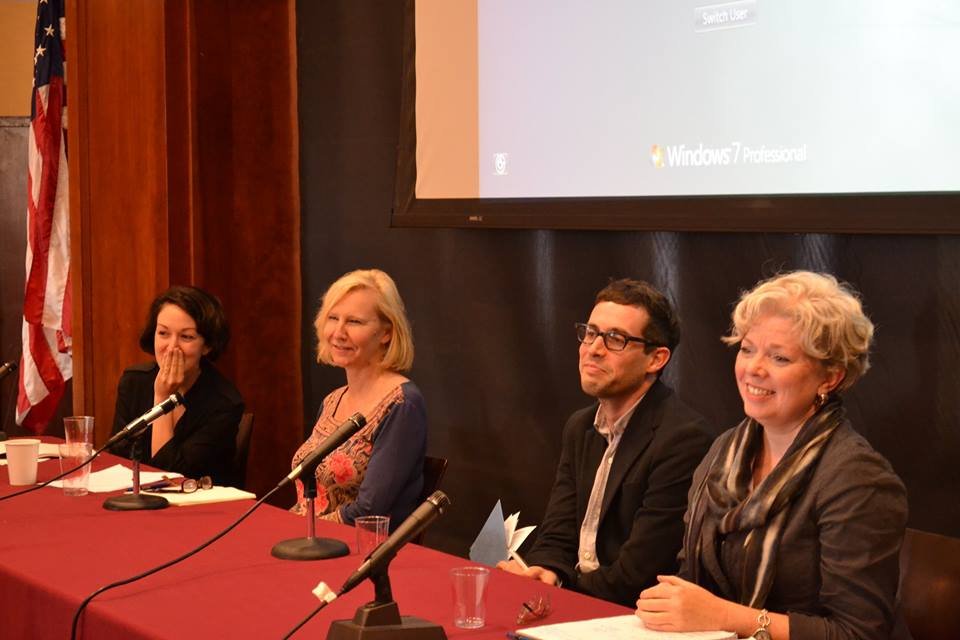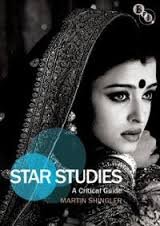Scholars Gather to Rethink Realist Acting
Tony-winning director Kenny Leon joined theater and film scholars from Fordham and around the world to discuss the prospect of “Rethinking Realist Acting” as part of a highly successful symposium in mid-September. The event was organized and hosted by Shonni Enelow and Keri Walsh, both assistant professors in the English Department at Fordham University, in partnership with Mary Luckhurst of the University of Melbourne in Australia, and administered by Callie Gallo, a doctoral student in the Fordham English department. The event, held at Fordham’s Lincoln Center campus from September 18-20, was very well-attended both by members of the Fordham community (faculty, administrators, graduate students, and a large number of undergraduates) and by members of the scholarly and creative communities of New York.
One of the paradigms for “rethinking” included the temporal boundaries of the subject, which is typically dated to the late nineteenth century (and the plays of Henrik Ibsen). Speakers at the event helped re-frame the topic as something worth pursuing further back into the 19th and even the 18th centuries. Fordham’s Stuart Sherman explored the use of prologues and epilogues on the eighteenth century stage to complicate our understanding of the topicality of these plays, and the ways they played with the boundaries between the real and the imagined (for instance in tragic death scenes followed by lively parting epilogues). In “Partitur: Scoring the Role,” Yale’s Joseph Roach discussed the 18th Century practice of “scoring the role,” developing the term partitur to describe these proto-subtextual scores, which he described as the beginning of realist acting. Sharon Marcus, Orlando Harriman Professor of Humanities at Columbia University, used the career of Sarah Bernhardt to suggest that the appearance of realism emerges more from a break with the conventions of the preceding generations’ acting styles than it does with anything actually more essentially “natural” in the particular performances. Sharon Marie Carnicke’s talk, “Acting Realism at the Moscow Art Theatre,” made a similarly relativizing claim, showing how in Chekhov’s The Seagull, scenes we recognize as bearing the hallmarks of “realism” emerge from the contrast with scenes performed in older theatrical styles, so that their realism emerges in dialectic with earlier melodramatic and declamatory styles.
In addition to reaching back further in history for the roots of realism, scholars at the conference also questioned common assumptions about the class, gender, race, ethnicity, and sexuality of “realism” as a genre. Rosemary Malague’s paper, “Realism and the Feminist Actress” presented the career of Stella Adler (teacher of Marlon Brando, Robert De Niro, and many others) in the context of the pressures on mid-century women’s lives that would be diagnosed by Betty Friedan in The Feminine Mystique, urging us to view Adler’s transformation from actor to teacher at mid-century in the social context of nascent feminism.
The conference featured several contributions from practitioners and original research on the process of acting. Mary Luckhurst of the University of Melbourne drew on interviews with actors including Jeremy Irons and Meryl Streep to understand the process of playing “real people” (that is, historical figures like Margaret Thatcher). Kenny Leon, Denzel Washington Chair in Theatre at Fordham for 2014-15 and director of the Tony Award-winning production of A Raisin in the Sun, performed a monologue from Fugard, Kani and Ntshona’s Sizwe Banzi is Dead and then discussed the exercises he uses in the acting classroom to help students understand the distinction between “realism” and “real life.”
Jacob Gallagher-Ross explored the relationship between acting and technology—especially audio recording technology—in Lee Strasberg’s work at the Actors Studio, demonstrating the centrality of audio recording to Strasberg’s ideas about realism and authenticitiy. To conclude the day’s talks, Cynthia Baron reflected on what constitutes realism on the screen, and studied some of the diverse realist styles to be found in American independent cinema since the 1970s.
Taken all together, the talks powerfully demonstrated what is to be gained from returning to realism to estrange or unsettle critical commonplaces about it. The project of rethinking realism in acting benefits from new thinking about realism in literature and also recent work in feminist and queer theory, critical race theory, cultural studies, and interdisciplinary modernism.
Two related Film Studies events took place in the days leading up to the conference. September 19 featured a panel on the burgeoning field of “star studies” and the work of the British Film Institute’s (BFI) “Film Stars” series. Students and faculty from various departments gathered to hear Fordham’s own Jacqueline Reich (Chair of Communication and Media Studies) as well as Martin Shingler of the University of Sunderland (UK) and series authors Cynthia Baron (Associate Professor of Theater and Film, Bowling Green) and Keri Walsh (Fordham), who spoke of their contributions and shared the various joys and difficulties of writing and publishing their scholarship. Martin Shingler opened the panel with a discussion of his role as the co-editor of the BFI’s film stars series. He explained his goals to spotlight less frequently studied actors (from non-Western celebrities to animated characters like Donald Duck) and to rediscover many actors who have been largely forgotten over time.
Cynthia Baron, Keri Walsh, and Jacqueline Reich then each highlighted their work on one specific actor, beginning with Baron, who explored the difficulties of reconciling divergent opinions on Denzel Washington. Walsh then described her Mickey Rourke “obsession” and the groundbreaking scholarship of Richard Dyer, which influenced Walsh not only by focusing on celebrity in a scholarly forum but also by writing in the “confessional” tone of a fan, with which Walsh immediately identified. Lastly, describing her work on the prolific Italian actor Marcello Mastroianni, Reich recounted the deceptively difficult task of writing about a celebrity as well as the insights Mastroianni’s work provides into notions of masculinity in early-twentieth-century Italy. Following these talks was an engaging question and answer period, which included questions about the changing legacies of deceased celebrities and the extension of star studies to include “low-culture” celebrities like Kim Kardashian.
On Thursday, September 18 Martin Shingler delivered a lecture in Walsh Library entitled “The Acting Prince: John Barrymore at Warner Bros., 1924-1931” in which he explored the continuities between Classicism, Neo-romanticism and Realism, acting styles which Barrymore employed not in succession (ie. leaving one behind to embrace another) but rather, in perpetual rotation as the various roles he took demanded. Following Shingler’s talk, graduate students and faculty (Eve Keller, Corey McEleney) joined together for a discussion of Paul Rudnick’s I Hate Hamlet, a 1991 comedy about an actor visited by the ghost of John Barrymore while preparing to play the role of Hamlet in Central Park, and a work its author described as a “tribute to actors.”
Sponsorship for all events came from Fordham’s Graduate School of Arts and Science, the English Department, Theatre Department, the Programs in Comparative Literature and Women’s Studies, and the University of Melbourne.





